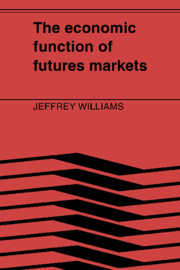Book contents
- Frontmatter
- Contents
- Preface
- 1 An introduction to futures markets
- 2 Equivalent ways to borrow and lend commodities
- 3 Futures markets and risk aversion
- 4 The demand to borrow commodities
- 5 The contribution of futures markets
- 6 The optimal number of futures markets
- 7 Conclusion: The economic function of futures markets
- Glossary of trade terms
- Reference list
- Index
1 - An introduction to futures markets
Published online by Cambridge University Press: 06 October 2009
- Frontmatter
- Contents
- Preface
- 1 An introduction to futures markets
- 2 Equivalent ways to borrow and lend commodities
- 3 Futures markets and risk aversion
- 4 The demand to borrow commodities
- 5 The contribution of futures markets
- 6 The optimal number of futures markets
- 7 Conclusion: The economic function of futures markets
- Glossary of trade terms
- Reference list
- Index
Summary
The hurly-burly of futures markets provides economists with a prime example of order arising from seeming chaos. The workings of commodity exchanges, such as margin rules, clearinghouses, and arcane terminology, result from the unplanned evolution of complex institutions. Futures prices are likewise the result of the interaction of brokers, speculators, and dealers in commodities, with no one firm or individual able to control prices. Yet the institutional features display compelling logic and futures prices remarkable consistency in their patterns. Because they exemplify competitive markets, futures markets bring into focus many areas of theoretical interest in economics, such as the role of risk aversion in people's decisions, the behavior of those storing commodities, and the market system's ability to digest information.
A study of the function of futures markets, therefore, can investigate the operation of actual markets as well as broader theoretical topics. This particular study aims mainly at theoretical topics rather than purely institutional questions such as the response of futures markets to changes in legal precepts. This study begins with the premise that understanding the motives of handlers of commodities is central to understanding futures markets. Without the business of handlers of commodities, futures markets wither away (Working 1954), contrary to the popular impression of the importance of speculation. Concentration on handlers of commodities illuminates two fundamental issues in particular: the reasons why futures prices have the patterns they do and the reasons why so few futures markets exist.
Handlers of commodities range from flour millers and soybean exporters to dealers in Treasury securities and mortgages. Because industries processing agricultural commodities or minerals are often easier to comprehend, the examples used here will mainly be about conventional primary commodities.
- Type
- Chapter
- Information
- The Economic Function of Futures Markets , pp. 1 - 40Publisher: Cambridge University PressPrint publication year: 1986



